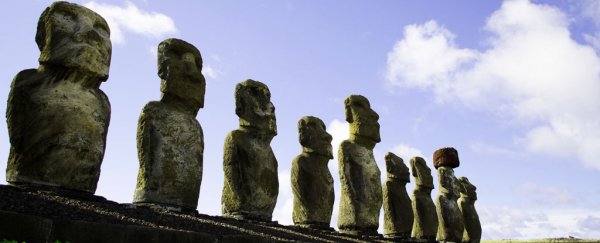When Dutch sailors became the first Europeans to lay eyes on Easter Island in 1722, they found two sets of figures staring back at them.
One gaze belonged to the remote island's Polynesian inhabitants – the Rapa Nui – but this human society was rivalled by a staggering population of almost 900 monolithic statues, and new research points to just how so much incredible stonework could have come to be.
The background of these statues, called the moai, has long been a mystery to scientists, as the first Europeans to visit Easter Island estimated the Rapa Nui population only numbered between 1,500 to 3,000 people – so how so many statues were erected, and when, has never been fully understood.
Now, a new analysis of the agricultural potential of the island provides evidence of how the Rapa Nui's numbers could have once been far greater than the dwindling population that remained in the 1700s.
"Despite its almost complete isolation, the inhabitants of Easter Island created a complicated social structure and these amazing works of art before a dramatic change occurred," says anthropologist Cedric Puleston from the University of California, Davis.
"It appears the island could have supported 17,500 people at its peak, which represents the upper end of the range of previous estimates."
Puleston and fellow researchers examined soil samples from around Easter Island and took readings from six weather stations located on the island over the course of two years.
Based on their analysis of the soil and the local climate conditions, the team thinks almost 20 percent of the island – some 3,134 hectares (12.1 square miles) – could have been used for the Rapa Nui's main food crop, sweet potatoes.
Using modelling and data from other island communities, the team came up with their numbers – running from approximately 3,000 individuals at the low end to more than 29,000 individuals at the high end – which outstrips previous estimates of the island's vanished population.
"The result is a wide range of possible maximum population sizes, but to get the smallest values you have to assume the worst of everything," says Puleston.
"If we compare our agriculture estimates with other Polynesian Islands, a population of 17,500 people on this size of island is entirely reasonable."
Of course, it's worth bearing in mind that this is just a hypothetical estimate of how large the population may have been before Europeans arrived – not a firm proof that the Rapa Nui were once so many.
But it's not the first study to gauge the pre-European Rapa Nui society based on dietary evidence, and large estimates like this could help to explain how the vast, solemn moai are themselves so dispersed and numerous.
As for what ultimately happened to this once thriving society, nobody knows for sure.
Various explanations exist, suggesting the Rapa Nui used up their resources too quickly, or succumbed to disease, potentially contracted from their first exposure to Europeans.
We still don't have a clear answer on that, but the amazing stone legacy that survives them is a testament to their unique civilisation.
"Easter Island is fascinating because it represents an extreme example of a natural experiment in human adaptation, which began when people from a single cultural group spread quickly across the islands of the Pacific," Puleston says.
"The different environments they encountered on these islands generated a tremendous amount of variation in human behaviour."
The findings are reported in Frontiers in Ecology and Evolution.
